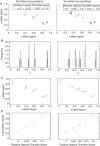Assignment of SNP allelic configuration in polyploids using competitive allele-specific PCR: application to citrus triploid progeny
- PMID: 23422023
- PMCID: PMC3605964
- DOI: 10.1093/aob/mct032
Assignment of SNP allelic configuration in polyploids using competitive allele-specific PCR: application to citrus triploid progeny
Abstract
Background: Polyploidy is a major component of eukaryote evolution. Estimation of allele copy numbers for molecular markers has long been considered a challenge for polyploid species, while this process is essential for most genetic research. With the increasing availability and whole-genome coverage of single nucleotide polymorphism (SNP) markers, it is essential to implement a versatile SNP genotyping method to assign allelic configuration efficiently in polyploids.
Scope: This work evaluates the usefulness of the KASPar method, based on competitive allele-specific PCR, for the assignment of SNP allelic configuration. Citrus was chosen as a model because of its economic importance, the ongoing worldwide polyploidy manipulation projects for cultivar and rootstock breeding, and the increasing availability of SNP markers.
Conclusions: Fifteen SNP markers were successfully designed that produced clear allele signals that were in agreement with previous genotyping results at the diploid level. The analysis of DNA mixes between two haploid lines (Clementine and pummelo) at 13 different ratios revealed a very high correlation (average = 0·9796; s.d. = 0·0094) between the allele ratio and two parameters [θ angle = tan(-1) (y/x) and y' = y/(x + y)] derived from the two normalized allele signals (x and y) provided by KASPar. Separated cluster analysis and analysis of variance (ANOVA) from mixed DNA simulating triploid and tetraploid hybrids provided 99·71 % correct allelic configuration. Moreover, triploid populations arising from 2n gametes and interploid crosses were easily genotyped and provided useful genetic information. This work demonstrates that the KASPar SNP genotyping technique is an efficient way to assign heterozygous allelic configurations within polyploid populations. This method is accurate, simple and cost-effective. Moreover, it may be useful for quantitative studies, such as relative allele-specific expression analysis and bulk segregant analysis.
Figures




Similar articles
-
Inheritance in doubled-diploid clementine and comparative study with SDR unreduced gametes of diploid clementine.Plant Cell Rep. 2016 Aug;35(8):1573-86. doi: 10.1007/s00299-016-1972-4. Epub 2016 Apr 2. Plant Cell Rep. 2016. PMID: 27038940
-
Genetically based location from triploid populations and gene ontology of a 3.3-mb genome region linked to Alternaria brown spot resistance in citrus reveal clusters of resistance genes.PLoS One. 2013 Oct 8;8(10):e76755. doi: 10.1371/journal.pone.0076755. eCollection 2013. PLoS One. 2013. PMID: 24116149 Free PMC article.
-
Genotyping of polyploid plants using quantitative PCR: application in the breeding of white-fleshed triploid loquats (Eriobotrya japonica).Plant Methods. 2021 Sep 3;17(1):93. doi: 10.1186/s13007-021-00792-9. Plant Methods. 2021. PMID: 34479588 Free PMC article.
-
Recent progress and challenges in population genetics of polyploid organisms: an overview of current state-of-the-art molecular and statistical tools.Mol Ecol. 2014 Jan;23(1):40-69. doi: 10.1111/mec.12581. Epub 2013 Nov 27. Mol Ecol. 2014. PMID: 24188632 Review.
-
Natural pathways towards polyploidy in animals: the Squalius alburnoides fish complex as a model system to study genome size and genome reorganization in polyploids.Cytogenet Genome Res. 2013;140(2-4):97-116. doi: 10.1159/000351729. Epub 2013 Jun 18. Cytogenet Genome Res. 2013. PMID: 23796598 Review.
Cited by
-
Marine transmissible cancer navigates urbanized waters, threatening spillover.Proc Biol Sci. 2024 Feb 28;291(2017):20232541. doi: 10.1098/rspb.2023.2541. Epub 2024 Feb 21. Proc Biol Sci. 2024. PMID: 38378149 Free PMC article.
-
Characterization of Chromosome Inheritance of the Intergeneric BC2 and BC3 Progeny between Saccharum spp. and Erianthus arundinaceus.PLoS One. 2015 Jul 21;10(7):e0133722. doi: 10.1371/journal.pone.0133722. eCollection 2015. PLoS One. 2015. PMID: 26196281 Free PMC article.
-
Origin of C. latifolia and C. aurantiifolia triploid limes: the preferential disomic inheritance of doubled-diploid 'Mexican' lime is consistent with an interploid hybridization hypothesis.Ann Bot. 2018 Mar 5;121(3):571-585. doi: 10.1093/aob/mcx179. Ann Bot. 2018. PMID: 29293884 Free PMC article.
-
Association of TFAP2A gene polymorphism with susceptibility to non-syndromic cleft lip with or without palate risk in south Indian population.Meta Gene. 2016 Jul 9;9:181-4. doi: 10.1016/j.mgene.2016.07.007. eCollection 2016 Sep. Meta Gene. 2016. PMID: 27617216 Free PMC article.
-
Inheritance in doubled-diploid clementine and comparative study with SDR unreduced gametes of diploid clementine.Plant Cell Rep. 2016 Aug;35(8):1573-86. doi: 10.1007/s00299-016-1972-4. Epub 2016 Apr 2. Plant Cell Rep. 2016. PMID: 27038940
References
-
- Ahmadian A, Gharizadeh B, Gustafsson AC, et al. Single-nucleotide polymorphism analysis by pyrosequencing™. Analytical Biochemistry. 2000;280:103–110. - PubMed
-
- Aleza P, Juarez J, Hernandez M, Pina JA, Ollitrault P, Navarro L. Recovery and characterization of a Citrus clementina Hort. ex Tan. ‘Clemenules’ haploid plant selected to establish the reference whole Citrus genome sequence. BMC Plant Biology. 2009a;9(110) http://dx.doi.org/10.1186/1471-2229-9-110 . - PMC - PubMed
-
- Aleza P, Juarez J, Ollitrault P, Navarro L. Production of tetraploid plants of non apomictic citrus genotypes. Plant Cell Reports. 2009b;28:1837–1846. - PubMed
-
- Aleza P, Juarez J, Cuenca J, Ollitrault P, Navarro L. Recovery of citrus triploid hybrids by embryo rescue and flow cytometry from 2x × 2x sexual hybridisation and its application to extensive breeding programs. Plant Cell Reports. 2010;29:1023–1034. - PubMed
Publication types
MeSH terms
LinkOut - more resources
Full Text Sources
Other Literature Sources

